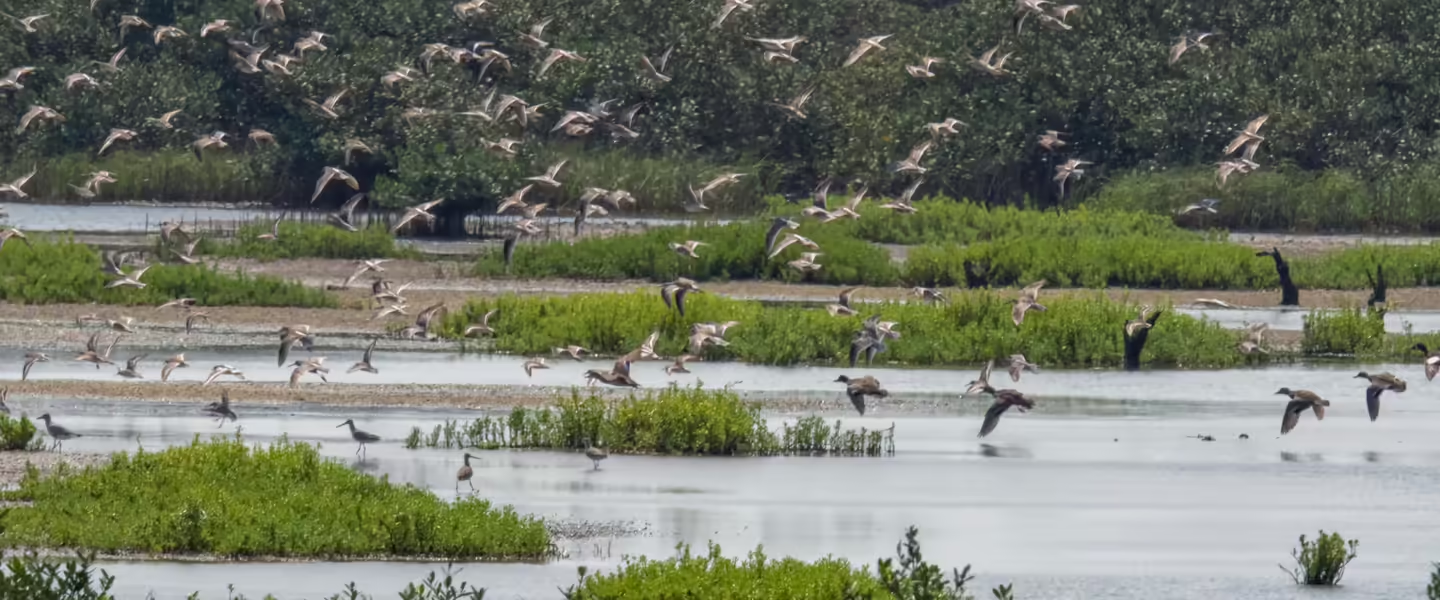As legal efforts fall short, residents are pursuing a novel strategy to halt the building of export terminals on unspoiled wetlands: Lobby Europeans to reject gas from the US.
|
Listen To This Story
|
This story by Aaron Cantú was originally published by Capital & Main and is part of Covering Climate Now, a global journalism collaboration strengthening coverage of the climate story.
•
In the Rio Grande Valley along the US-Mexico border, residents are battling to preserve some of the last pristine wetlands on the Texas coast. They had won some victories against businesses building terminals to ship millions of tons of liquefied natural gas (LNG), an atmosphere-heating fossil fuel, to Europe and Asia from Brownsville.
A scrappy group of activists whose families have lived in the area for centuries delayed construction as locals urged regulators to reject the terminals. Following legal action brought by the Sierra Club and other South Texas groups, a federal agency reassessed the potential environmental impacts of the projects. And the activists, through a sophisticated strategy of teaming up with European allies, persuaded key financial backers to withdraw support.
But the terminal projects are moving forward, picking up momentum as the US and Europe seek energy security following the disruption to gas supplies caused by the Russian invasion of Ukraine. One terminal received permission from federal regulators to construct a levee and an offloading facility. The other has all state and federal permits, but has yet to break ground.
As the prospects that US regulators will stop the building of the gas export terminals dim, residents are doubling down on lobbying in Europe. The Texans and their European allies have held rallies and news conferences in countries including Germany, Spain, and France.
Their message: Export terminals in the US exploit Latino and Black communities, exacerbate the climate crisis, and worsen air pollution in Europe. Why not double down on solar and wind instead? Their hope is that Europeans will persuade their governments to speed up the buildout of renewable energy sources. Doing so, they believe, would cut off the demand for liquefied natural gas from Texas.
“We’re going to try everything we can, and yell at any company, bank or investor who is involved,” said Bekah Hinojosa, co-founder of South Texas Environmental Justice Network, who has been leading these efforts.
The gas, the same kind used for stoves and to produce electricity in power plants, will be shot hundreds of miles through pipelines from fracking fields in West and East-Central Texas. Once it reaches Brownsville, companies will cool the gas until it turns to liquid, decreasing the volume and allowing more of it to be loaded onto tankers.
The Sierra Club estimates the terminals will create as many greenhouse gas emissions as 46 million cars a year. That is about 21 times the companies’ claims. The Sierra Club accounts for the leakiness of methane, the primary ingredient in gas. Methane molecules trap more of the sun’s heat in the atmosphere than carbon dioxide, the primary greenhouse gas emitted by the burning of fossil fuels.
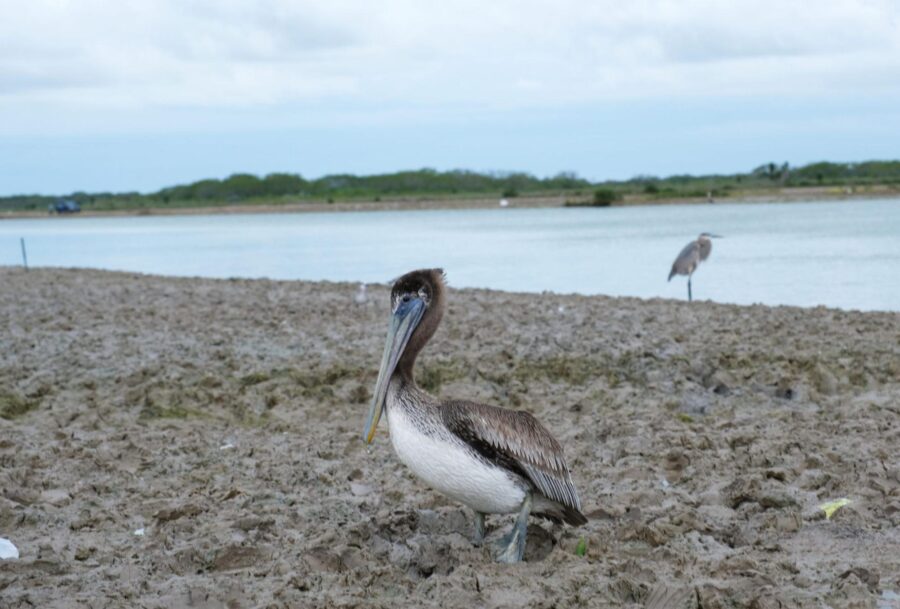
Photo credit: Aaron Cantú
The gas industry argues that their product is essential for reducing emissions from coal, which releases more carbon when it is burned. But advances in satellite methane detection are showing that leaks at pipelines and gas fields are worse than previously believed. Recent research, still under peer review, found methane leaks in gas supply chains make it cumulatively on par with coal — prompting the Biden administration to review how it assesses climate impacts of liquefied natural gas terminals.
Worldwide emissions are on track to eclipse the limit set by the 2016 Paris Agreement ratified by nearly all members of the United Nations. That limit is what scientists say is necessary to stop the most catastrophic effects of a warming planet. The only hope of slowing that temperature rise, according to the UN, is to stop building new fossil fuel facilities and phase out existing ones by 2050.
The UN’s warning, as part of its Sixth Assessment Report, coincided with the outbreak of war in Ukraine. In order to isolate Russia, President Biden pursued a ramp up of gas exports, transforming the US into the biggest liquefied natural gas supplier in the world. When regulators approved the Brownsville terminals even after a lawsuit, fighting them looked like a lost cause. But opponents dug in their heels. Now it is no longer inconceivable to think they might win.
Locals Have Put Companies on the Ropes
On much of the Texas coast, wetlands were paved over to build oil and gas refineries. But the coastline of the Rio Grande Valley remains untouched. Just south of the resorts at South Padre Island, brown pelicans waddle in the mud alongside the channel of the port of Brownsville. Soon it could be dredged to accommodate tankers, each nearly as long as a track field. They would pass through sensitive habitats in estuaries and salt marshes to take the gas on its voyage.
Crews are clearing brush for the larger of the terminals, Rio Grande LNG, which is owned by the company NextDecade. A smaller proposed terminal called Texas LNG, owned by Glenfarne Group, will be adjacent and has no facilities yet. The combined acreage of the two sites spans 2.5 square miles, almost the size of the city of South Padre Island.
The steel complexes will be illuminated by the orange glow of flared gas. The gas will flow there in pipelines 3.5 feet in diameter. Turbines powering compressors will pressurize the gas in the presence of refrigerants until the methane condenses into liquid at -260 degrees Fahrenheit. Machines called thermal oxidizers will strip the gas of unprofitable compounds like carbon dioxide and hydrogen sulfide, a toxin, and vent them into the sky.
The companies were welcomed by regional economic interests as a boost for employment and industries in the valley, where a quarter of 1.4 million people live in poverty. But they also encountered backlash. Fearing impacts to shrimping and tourism businesses, and to rare ground animals, birds and plantlife, local town councils passed resolutions opposing the terminals. Although NextDecade secured a $373 million tax break from Cameron County, a school district denied both Rio Grande LNG and Texas LNG similar incentives — a rare outcome in Texas.
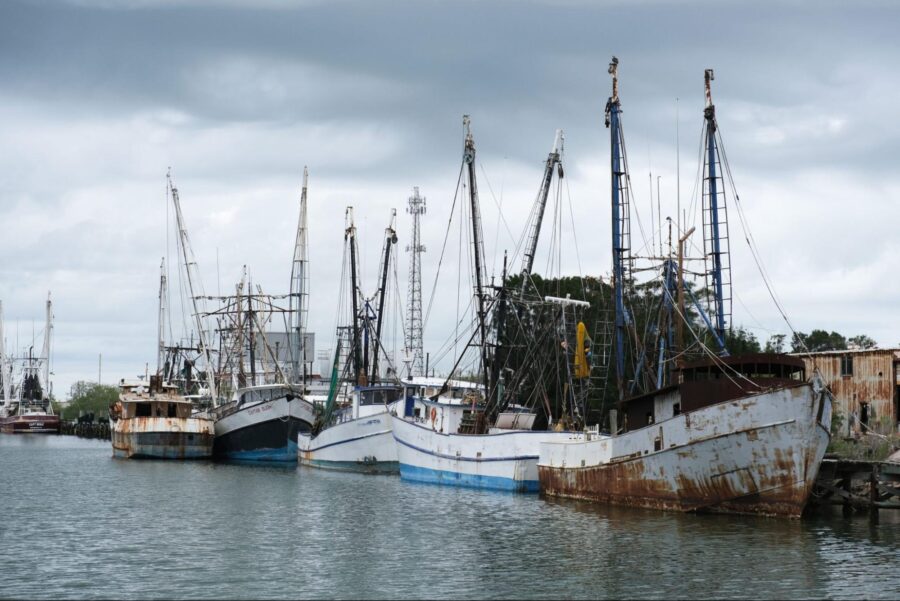
Photo credit: Aaron Cantú
Among the locals resisting is Juan Mancias, chairman of the Carrizo/Comecrudo Tribe of Texas (Esto’k Gna). Built like a linebacker with long silver hair, Mancias has become a fixture in South Texas, as the tribe has protested major developments over the last decade, including the LNG terminals; a rocket production facility and launch pad as well as land acquisition for Elon Musk’s company SpaceX; and eminent domain fights to build the US-Mexico border wall.
Amid prickly pear cactus and Spanish dagger set to be cleared for the terminals, shards of pottery and other remnants of ancient people are buried in clay dunes. A portion of the area includes the Garcia Pasture, a sacred site for the Carrizo/Comecrudo. It was the grounds of a pre-Columbian village and is now listed in the National Register of Historic Places.
Rio Grande LNG says its terminal will be built 1,000 feet away from Garcia Pasture, which they claim will not be disturbed. In a legal filing, Texas LNG said that it examined state records and investigated the site, and found that “occupations at the Garcia Pasture site [were] not as extensive as previously suggested.” In a response to Texas LNG, the National Park Service said it was concerned the company “did not do a thorough enough job” researching the site. It warned the pasture’s remaining archeological treasures could be “lost” if the terminal moves forward.
Companies are using the poorly documented history of the land to justify desecrating it, said Mancias. The nomadic people who lived there moved frequently along the coastline — something he knows because of oral history passed on to him through relatives. “It doesn’t take an idiot to recognize the fact that you are walking on the bones of people who live there in those fishing villages,” Mancias said. The Carrizo/Comecrudo bought land nearby to block access for gas company Enbridge, which wants to survey the land to build two pipelines to Rio Grande LNG. (None of the companies consented to an interview.)
The shipping terminals will emit thousands of tons of pollutants, some carcinogenic, that inflame the lungs and disrupt the flow of blood through the heart.
Many in the valley have ancestors native to South Texas and Mexico, but did not retain knowledge of their personal family histories through waves of European and American subjugation. Bekah Hinojosa, 33, confirmed her native ancestry through a DNA test taken by her father. She is organizing against the terminals as a way of reconnecting with her roots. “That is what I’m fighting for,” Hinojosa said, “preserving that ancestral heritage and that connection to land.”
In 2017, Hinojosa and Mancias kicked off the international campaign to divest from the terminals. With the backing of well-connected international groups like the Rainforest Action Network, they traveled to France, where they successfully lobbied the banks BNP Paribas and Société Générale to stop acting as financial advisors for the projects. The banks cited climate and human rights concerns as reasons they pulled out.
That effort drove more momentum abroad. Irish campaigners asked Hinojosa to help them stop an import terminal planned for Ireland’s southern coast. She traveled there and lobbied Port of Cork authorities to let the contract expire — which they did. In 2020, France blocked a deal for Rio Grande LNG to export gas to French utility company Engie, also out of concern for the climate.
Companies initially hoped to start exporting gas by the early 2020s. That proved impossible in the face of local pushback and plunging gas prices during the pandemic. A third company, Annova LNG, later scrapped plans altogether for another Brownsville terminal. But the other two got a boost from regulators and war in Europe.
Regulators OK Terminals After Biden Liquefied Natural Gas Order
The terminals will emit thousands of tons of nitrogen oxides and carbon monoxide, and hundreds of tons of particulate matter and volatile organic compounds. All are pollutants, some carcinogenic, that inflame the lungs and disrupt the flow of blood through the heart. Residents are also wary of the planet-warming effects of millions of tons of greenhouse gas emissions. The valley’s saturating heat is becoming stormier and more unbearable, while South Padre’s sea level rose 7 inches since the 1950s, higher than the national average.
The Federal Energy Regulatory Commission (FERC), when approving the terminals, did not consider the effects of greenhouse gas emissions. Their Final Environmental Impact Statements, issued in 2019, said because “there is no universally accepted methodology” to measure the impact of climate emissions, “we are not able to assess potential [greenhouse gases] related impacts attributable to this project.”
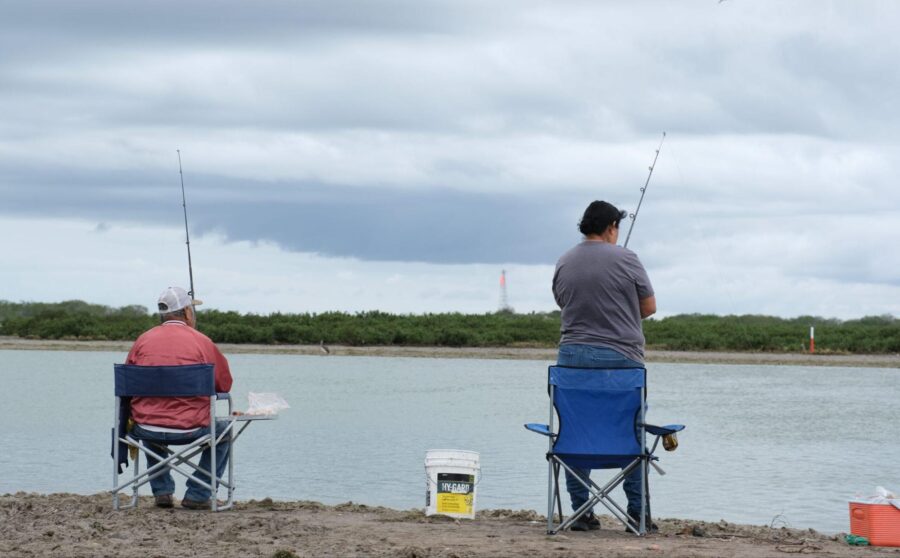
Photo credit: Aaron Cantú
The FERC reports also included an unusual interpretation of the projects’ “disproportionate” impacts on low-income, minority communities. All but one of the communities within 2 miles of the terminals are majority Latino and have poverty rates greater than 20 percent. FERC’s conclusion was that because Cameron County, where the projects are located, is 90 percent Latino and has a 23 percent poverty rate, residents of the immediate area are not disproportionately affected. One of the FERC commissioners, Richard Glick, expressed astonishment at his colleagues’ findings, calling them “hard to fathom” in a dissenting opinion.
The Sierra Club and a local community organization, Vecinos para el Bienestar de la Comunidad Costera, filed a lawsuit in September 2020 claiming the assessments incorrectly found the terminals to be in the public interest. The following August, three federal appeals court judges unanimously agreed, writing that FERC did not follow a law directing it to use methods “generally accepted in the scientific community” when assessing climate emissions. The judges also ruled that FERC needed to clarify why it chose to analyze only a 2-mile radius if the projects’ effects would actually span 31 miles.
Six months after the ruling, Biden called for increasing liquefied natural gas exports to Europe following Russia’s invasion of Ukraine. In April 2023, FERC issued an order reauthorizing the projects after conducting an additional environmental assessment. In a legal filing, it estimated the “social cost” of greenhouse gas emissions from Rio Grande LNG and the associated Rio Bravo Pipeline system would be up to $18.04 billion and $2.06 billion, respectively, and Texas LNG’s at $2.02 billion. The commission also determined the facilities would impact low-income minority residents within 31 miles but still comply with the Clean Air Act.
Many European nations that prohibit fracking have become top destinations for Gulf Coast gas.
A dissenting commissioner, Allison Clements, noted that FERC held no public hearings, despite a federal law that says communities should be consulted when an agency is identifying environmental justice concerns. Clements also wrote that the public did not have a chance to assess the modeling information FERC used to determine the air pollution levels would be legal. In sum, she wrote, FERC had published “a fundamentally flawed record that cannot support a public interest determination for either project.”
The Sierra Club asked the appeals court to review FERC’s decision. It has not yet ruled. In the meantime, FERC has allowed Rio Grande LNG to pour a concrete foundation and build a deck for tankers to berth. It is also moving soil to raise the embankment around the shipping channel. The Sierra Club is asking the court to halt this activity while litigation is active.
Bypassing Courts and Regulators, Activists Look Outside Texas
Shortly after the outbreak of the Ukraine war, Rio Grande LNG finalized its contract with Engie, the French utility. A purchase agreement with another importer, TotalEnergies, makes French companies the terminal’s biggest customers. Others include Portuguese, Chinese, and Japanese importers — though buyers can receive the shipments anywhere that abides US export laws.
To allay climate concerns, Rio Grande LNG owner NextDecade pledged to capture carbon emissions from the liquefaction process and gas turbines. That would address only a portion of the total pollution linked to the project, leaving out fracking in the methane-emitting Permian Basin, leaks during transport, and the end use of the gas by consumers.
Last year Germany, Portugal, and Spain generated more electricity from solar and wind than from gas for the first time.
In response to companies regrouping, activists deepened their relationships in Europe. Many of those nations that prohibit fracking have become top destinations for Gulf Coast gas. Germany leads the way in fast-tracking import terminals, but expansions and reboots of old ones are happening in Portugal, the Netherlands, Greece, and Spain.
At the invitation of anti-coal alliance Ende Gelände, Carrizo/Comecrudo member Christopher Basaldú traveled to northern Germany with Elida Castillo, from the liquefied natural gas-exporting Texas city of Corpus Christi. The gathering culminated in a blockade of oil and gas shipments along the Kiel Canal, where Dutch company Gasunie is building an import terminal.
Listening to the Americans speak about pollution back home, Andy Gheorghiu, a German anti-LNG campaigner, realized he needed “to start working on the transatlantic perspective to understand the fuller story of the fracked gas supply chain.” Europeans and Americans began meeting virtually to plan a delegation of Gulf Coast activists to cities in Europe with import terminals. Last October, at a press conference in Wilhelmshaven, a port town along the North Sea where Germany and company Uniper operate an import terminal, women from the Texas and Louisiana coastlines spoke of living in the shadow of industry. Hinojosa criticized plans to turn Brownsville into a “colony for the extraction of fossil fuels” shipped to Europe.
Despite a bump in demand following the start of the war, last year Germany, Portugal, and Spain generated more electricity from solar and wind than from gas for the first time. Long-term forecasts show Europe needing less gas, a reality that the industry acknowledges. “In Europe gas demand will keep on decreasing, there is no doubt about this,” said Laurent David, a former gas executive in France who now serves as the General Delegate for the International Group of Liquefied Natural Gas Importers.
With economic headwinds in their favor, activists are protesting in multiple nations against liquefied natural gas financers. Hinojosa and anti-gas activists in Madrid blocked an entranceway at the headquarters of investor Banco Santander. They condemned the “cancer factories” in Brownsville and Huelva, a city in southern Spain with an import terminal. Banco Santander is backing Rio Grande LNG with a billion-dollar loan. Activists have referenced its membership in the UN’s Net-Zero Banking Alliance to highlight what they say is a contradiction between words and actions. Eight other banks that signed the pledge are invested in Rio Grande LNG.
In the US, they are pressing pension funds in Washington state and Oregon to move $750 million out of Global Infrastructure Partners, a private equity firm invested in Rio Grande LNG. The firm is owned by BlackRock, a signatory of the UN’s Net Zero Asset Managers initiative.
And they are taking aim at Rio Grande LNG insurers Sompo, Chubb, and Liberty Mutual — which together saw revenues fall by more than $1 billion last year due in part to natural catastrophes, a fact opponents say highlights the illogic of insuring fossil fuel projects. For years, the international climate movement protested at the offices of coal insurers, calling and emailing them and publicly shaming them. Many insurers have since adopted policies against selling policies to coal mines and power plants, and activists hope to do the same for liquefied natural gas exports by lobbying companies not to insure terminals.
“By putting pressure now, it’s more likely the next round of infrastructure won’t get financed.”
~ Clark Williams-Derry, energy finance analyst, Institute for Energy Economics and Financial Analysis
In February, Rio Grande Valley residents flew to New York to protest outside of Global Infrastructure Partners and major liquefied natural gas insurers. They were joined by peers from across the Gulf Coast and dozens of climate campaigners. In a video of the protests, Juan Mancias’ daughter, Carrizo/Comecrudo Executive Director Christa Mancias, shared a bullhorn with Hinojosa as they marched in front of corporate offices on Sixth Avenue. “We’re no longer wanting to be a checked box” for corporate compliance, the younger Mancias declared.
They continued down the block toward the skyscraper housing AIG, a major fossil fuel insurer. At the front of the march, Juan Mancias held a white banner demanding an end to Rio Grande LNG. A breakaway group of protesters tried rushing through the building’s doorway. In a knot of elbows and grimaces, guards wearing black ties repelled the charge. One of them wrapped his arm around a protester’s neck. After police showed up, a cop briefly detained another guard in the chaos. Protests against fossil fuel insurers took place in 31 countries that week as part of Insure Our Future coalition’s Global Week of Action.
Terminals in Progress but Remain Vulnerable
Time is running out to stop the Texas LNG terminal before crews start clearing land. In March the company secured a sales and purchase agreement with Switzerland-based Gunvor Group. Those agreements are critical for companies to reach a final investment decision on whether to start a major project. By comparison, Rio Grande LNG already has several future buyers under contract, and last summer reached a final investment decision for the first phase of the terminal. Even if the activists can force owner NextDecade to go bankrupt, its lenders or other investors could take over the operations.
Still, delays can be damaging. Maybe an insurer quits, halting construction. Or the terminal only gets partially built and loses money. As of Dec. 31, NextDecade had $38.2 million on hand, creating “substantial doubt” about its future, it said in financial records. By the time Rio Grande LNG is supposed to start exporting gas in 2028, the world will have an oversupply from too many export terminals in the US and other countries, including Qatar, some analysts predict.
“By putting pressure now,” said Clark Williams-Derry, an energy finance analyst at the Institute for Energy Economics and Financial Analysis, a think tank focused on accelerating the transition from fossil fuels, “it’s more likely the next round of infrastructure won’t get financed.” Liquefied natural gas industry representatives respond that predictions of a glut are overblown. They say importers in Asia, including China, Indonesia, and Malaysia, can absorb the increase in supply.
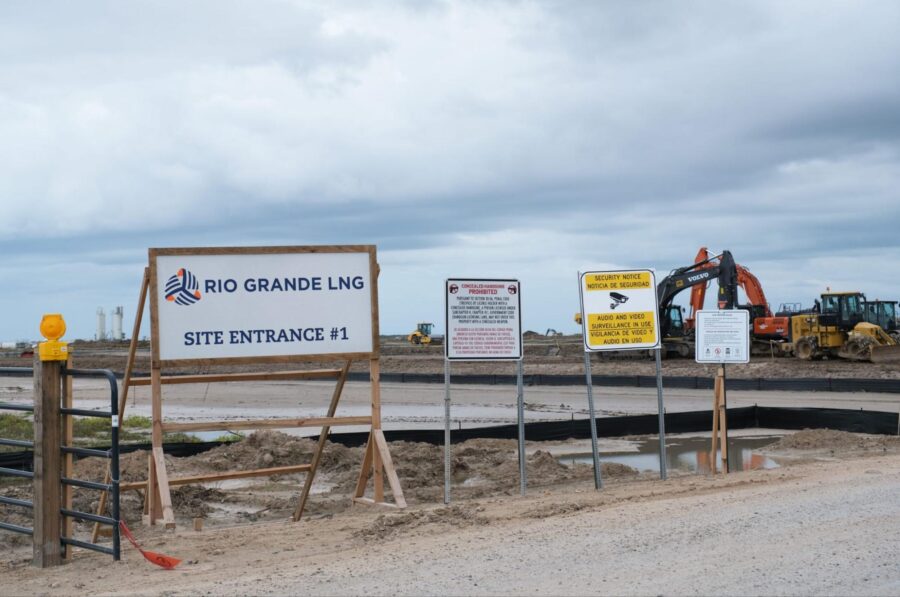
Photo credit: Aaron Cantú
Juan Mancias has kept an eye on that horizon. He is planning a trip to Japan, where the company Itochu is slated to receive gas from Brownsville, to network with allies. The liquefied natural gas fight is still galvanizing residents in the valley. On a recent evening, Mancias met with community members to discuss elections at the Brownsville Navigation District, which holds the lease with Rio Grande LNG. A candidate for its board of commissioners, Josette Cruz Hinojosa — no relation to Bekah — traveled to Germany as part of the campaign against the terminals.
Mancias said, “We are not going to take anything anymore like in the past. We are not intimidated.” He is demanding reparations for the land clearing Rio Grande LNG has already done.
The gas export contracts span into the 2040s. The average world temperature is on track to rise 3.6 degrees Fahrenheit above pre-industrial levels during that time. At that temperature, the North Pole will likely be ice-free in summer, which has not happened in 2.6 million years. That will contribute to rising sea levels and, with a hotter ocean, make Katrina-level hurricanes two to seven times more likely, according to a Department of Energy report examining the exposure of coastal fossil fuel facilities to storm surges.
Climate change underscores “the importance of limiting investments in new critical infrastructure” in the path of storm-driven waves, said the report. It was published in 2015, a year before the US had any seaside liquefied natural gas export terminals. Today, 13 are in operation or under construction, and eight more were approved by regulators. But at least four were halted in January, following President Biden’s pause of approvals for LNG exports to countries without free trade agreements, which includes China and all of Europe. The Brownsville terminals were not affected because they already had approval.
The announcement said the government’s analyses underpinning export terminals “no longer adequately account” for their greenhouse gases and effects on domestic natural gas prices. “The pause,” it said, “will provide the time to integrate these critical considerations.”
